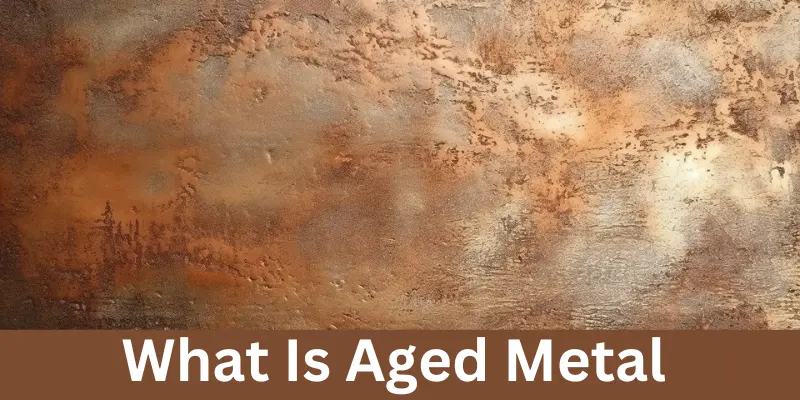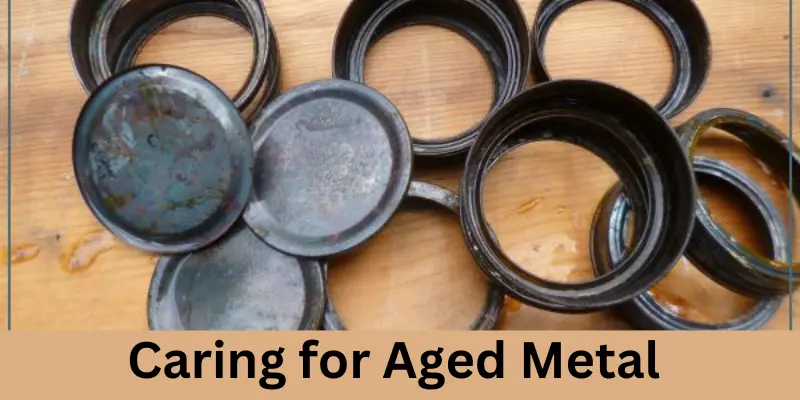Aged Metal | How Time Transforms Strength into Art
Updated: 15 Nov 2024
449
Introduction
Aged metal is more than just a weathered surface its a unique blend of beauty, history, and durability. Over time, metals like copper, steel, and bronze naturally develop a patina or rust, which adds character and charm.
This transformation is not just about appearance; its a process that enhances the metals strength and resilience. Whether used in art, architecture, or design, aged metal offers a timeless appeal that combines the old with the new, making it a valuable element in both functional and decorative projects.
What Is Aged Metal?

Aged metal is metal that has changed over time because of things like weather, air, and water. Metals like iron, copper, or steel can start to look rusty or have a greenish color. This happens naturally and gives the metal a unique, old look.
People use aged metal in art, buildings, and furniture because it looks cool and shows history. Its not just about how it looks aged metal is also stronger and more durable.
You May Also Visit It!
Spray Arc Welding – Step by Step Guide – Need Metals
Pre Coat Metal | Define Complete Guide- Need Metals
Mcelroy Metals – Types, Uses And Properties – Need Metals
Will Magnets Stick to Stainless Steel Refrigerator – Complete Guide
The Process of Aged Metal
The process of aging metal happens when it reacts with things like air, water, or chemicals. Over time, the surface of metals like copper, steel, and iron changes. For example, iron might rust, turning it reddish brown, while copper develops a green color.
Sometimes, people can speed up this process using special chemicals or techniques to make metal look older and cooler faster. Whether it happens naturally or on purpose, this aging process gives the metal a unique, antique appearance that people love.
Popular Types of Aged Metal
There are many types of aged metal that are popular because of their cool look and strong qualities. Here are a few:
- Rusted Steel: When steel gets exposed to water and air, it forms rust. This gives it a rough, reddish brown look that people like to use in art or buildings for a rustic feel.
- Copper: Copper turns a greenish color over time because of a process called patina. This is a natural change that happens when copper reacts with moisture and air. Its often used for outdoor sculptures or roofs.
- Bronze: Bronze is an alloy made from copper and tin. Over time, it can get darker or develop a beautiful green color. This aged look is loved for its antique style and is used in sculptures, coins, and jewelry.
- Brass: Brass, which is made from copper and zinc, also develops a nice golden brown or dark color as it ages. Many people use aged brass in home décor like lamps or door handles to add vintage charm.
- Iron: Like steel, iron can also rust, but it often turns a deeper reddish brown. Aged iron is often used for gates, fences, and even furniture, giving these items a timeless, classic look.
Each type of metal ages in its own special way, and thats what makes them so unique and desirable in design.
Uses and Applications of Aged Metal
Aged metal is used in many cool and creative ways. Here are some of its most popular uses:
- Art: Aged metals like copper and bronze are used to make sculptures and other artwork because their unique colors look beautiful over time.
- Architecture: Buildings, especially roofs, often use aged metal because it looks great and lasts a long time. For example, copper roofs can turn green as they age.
- Furniture: Aged metal is used in furniture like tables, chairs, and lamps to give them a vintage or rustic look.
- Jewelry: Some metals, like brass or copper, are used to make stylish, old fashioned jewelry.
- Outdoor Decor: People use aged metal for garden statues, fences, or gates because it looks interesting and can withstand the weather.
Aged metal helps things last longer and look amazing.
How to Age Metal at Home (DIY Techniques)
If you want to age metal at home and give it that cool, rusty look, heres how you can do it with some simple techniques:
1. Using Vinegar and Salt
- Materials: Metal object, vinegar, salt, spray bottle.
- Steps: Mix salt and vinegar in a spray bottle. Spray the mixture on the metal and let it sit for a few hours. You will see it start to change color and get a rustic, aged look.
2. Creating Patina with Ammonia
- Materials: Copper or bronze item, ammonia, plastic bag.
- Steps: Place the metal inside a plastic bag with a small container of ammonia. Seal the bag and let it sit for a few days. The ammonia will create a greenish patina, just like copper ages naturally.
3. Using Baking Soda for a Rusty Look
- Materials: Metal object, baking soda, water, and a brush.
- Steps: Mix baking soda and water to make a paste. Brush it onto the metal and let it sit. After some time, you will see the metal start to develop a rusty appearance.
4. Rubbing the Metal with Steel Wool
- Materials: Steel wool, metal object.
- Steps: Gently rub steel wool on the metal to create scratches and a worn look. This will make it look older, even without adding rust or patina.
These simple steps can help you create aged metal pieces that look just like they have been around for years.
Common Mistakes to Avoid When Aging Metal
1. Overdoing It
- Sometimes, people go too far with aging techniques, like applying too much vinegar or salt. This can make the metal look too rusty or damaged. Its best to start slow and build up the effect gradually.
2. Not Testing First
- Always test on a small part of the metal before applying a technique to the whole item. Some metals react differently, so testing ensures you get the look you want.
3. Using the Wrong Chemicals
- Certain chemicals can damage the metal or cause dangerous reactions. Always use safe materials and follow instructions carefully, especially when working with things like ammonia.
4. Skipping Safety
- Do not forget to wear gloves and goggles when working with chemicals like ammonia or vinegar. These can be strong, and you need to protect your skin and eyes.
5. Being Too Impatient
- Aging metal takes time, so do not rush the process. Some techniques need a few days to show results, and trying to speed things up can ruin the effect.
By avoiding these mistakes, you well be able to safely and successfully age your metal items at home.
Caring for Aged Metal

Caring for aged metal is important if you want it to last and look great. Here are some easy tips to help you take care of it:
- Clean Gently: Use a soft cloth to wipe away dust or dirt. Don not scrub too hard, or you might damage the metals surface.
- Avoid Harsh Chemicals: Stay away from strong cleaning products, as they can damage the metals patina or rust. Stick to mild soap and water.
- Keep It Dry: Moisture can cause more rust, so try to keep your metal items dry, especially if they are outdoors.
- Apply a Protective Coating: You can use a clear wax or sealant to protect the metal from further wear and tear. This helps keep the aged look for a longer time.
- Check for Damage: Regularly check your metal pieces for any signs of cracking or damage. Fixing small problems early can prevent bigger ones later.
By following these simple steps, your aged metal will stay looking beautiful for years.
You May Also Visit It!
Forging Process | Metal Becomes Tools and Parts – Easy Explanation
History of Nickel | From Ancient Coins to Modern Technology
Metal Does a Magnet Not Stick To | Uses and Types
Physical Properties Are Shared by Most Metals
Advantages and Disadvantages of Aged Metal
Advantages of Aged Metal
| Advantages |
|---|
|
Disadvantages of Aged Metal
| Disadvantages |
|---|
|
Common FAQs About Aged Metal
What is aged metal?
Aged metal is metal that has gone through a process of natural or artificial aging, resulting in a worn, rusty, or patina covered surface that gives it a vintage or weathered appearance.
How do you age metal?
You can age metal using techniques like spraying it with vinegar and salt, using ammonia to create a patina, or rubbing it with steel wool for a distressed look.
Is aged metal durable?
Yes, aged metal is often more durable, especially when it forms a protective layer like rust or patina. However, if not properly sealed or maintained, it can still corrode further.
Can I age metal at home?
Yes. There are simple DIY techniques using common materials like vinegar, baking soda, or ammonia to age metal at home.
What are the uses of aged metal?
Aged metal is commonly used in home décor, furniture, art, and outdoor structures. It gives a rustic or industrial look and adds character to designs.
Does aged metal require maintenance?
Aged metal is generally low maintenance, but it may need occasional cleaning or re sealing to preserve its look and prevent excessive corrosion.
Can aged metal be used for modern designs?
Aged metal fits best with rustic, vintage, or industrial styles. It might not always blend well with sleek, minimalist, or modern designs.
Is aged metal expensive?
Aged metal can be pricey, especially if its a rare antique piece or carefully aged for a specific look. However, DIY methods can help you achieve an aged look at a lower cost.
Bonus Points on Aged Metal
- Eco friendly: Using recycled metals for aging reduces the need for new materials, contributing to sustainability.
- Customizable Looks: Aging processes can be adjusted for different color effects and textures.
- Increases Value: Aged metal can appreciate over time, especially in the case of antique or vintage items.
- Low Environmental Impact: Natural aging causes fewer pollutants compared to factory made metals.
- Perfect for Outdoor Use: Once aged, metal can withstand outdoor conditions better due to its protective layer.
- Increased Character: The natural aging process adds personality, making each piece unique.
- Durability with a Touch of History: Aged metal brings both strength and a sense of history to a design.
- Versatile for Various Styles: Aged metal fits both rustic and modern industrial aesthetics.
- Adds Texture: Its uneven texture adds depth and interest to projects.
- Timeless Appeal: The vintage look never goes out of style, ensuring your projects always remain trendy.
Conclusion
Aged metal adds a unique, timeless charm to designs with its rustic and vintage look. While it offers durability, low maintenance, and environmental benefits, it also requires some care to avoid corrosion and damage.
Whether for home decor or DIY projects, aged metal can be a versatile material, but its important to maintain it properly. With the right techniques and attention, aged metal can continue to enhance spaces with its character and beauty for years to come.
You May Also Visit It!
Magnetic Materials | What Materials Are Attracted By Magnets – Benefits
Yield Strength of Metals: Types, Uses and Clear and Simple Overview
Heat Treating Steel | Key Temperatures for Hardening, Types and Uses
1075 or 1095 Steel | Find the Best Steel for Your Knife
Aluminium Metal, Types, Uses, Properties and Rust Aluminium
Please Write Your Comments